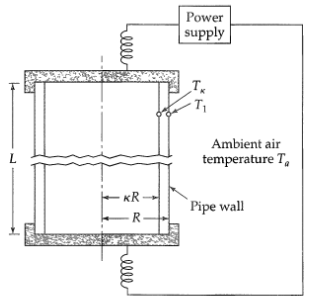Electrical heating of a pipe (Fig. 10B.8), in the manufacture of glass-coated steel pipes, it is common
Question:
Electrical heating of a pipe (Fig. 10B.8), in the manufacture of glass-coated steel pipes, it is common practice first to heat the pipe to the melting range of glass and then to contact the hot pipe surface with glass granules. These granules melt and wet the pipe surface to form a tightly adhering nonporous coat. In one method of preheating the pipe, an electric current is passed along the pipe, with the result that the pipe is heated (as in S10.2). For the purpose of this problem make the following assumptions:
(i) The electrical conductivity of the pipe ke is constant over the temperature range of interest. The local rate of electrical heat production Se is then uniform throughout the pipe wall.
(ii) The top and bottom of the pipe are capped in such a way that heat losses through them are negligible.
(iii) Heat loss from the outer surface of the pipe to the surroundings is given by Newton's law of cooling: qr = h(T1 - Ta). Here h is a suitable heat transfer coefficient. How much electrical power is needed to maintain the inner pipe surface at some desired temperature, TK, for known k, Ta, h, and pipe dimensions?

Step by Step Answer:






